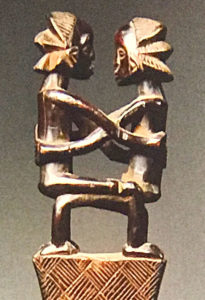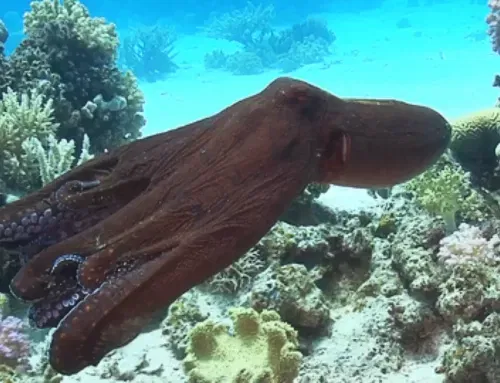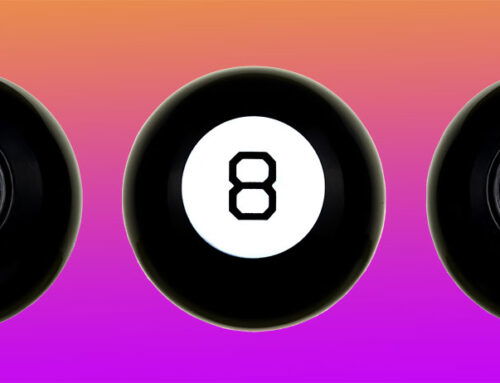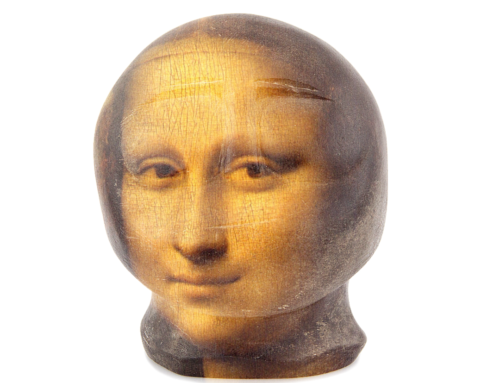Part 2 of a series on Creativity:
A friend looked at his wristwatch as we were finishing lunch. “1:20,” he said, “I still have some time before I have to leave.”
“What a beautiful watch!” I said, more impressed with his Patek Phillipe than with the time.
“Thanks,” he said. “It cost me all of $35.”
He told me it was a Patek Phillipe look-alike, a fake name on a cheap watch, a throw-a-way if it stopped working accurately. It must have had some trivial detail that differed from an original, but I couldn’t tell.
We spent the next half hour discussing authenticity. The touchy nature of authenticity can break hearts, topple reputations of proud collectors, bankrupt naïve collectors, and jail gallery owners selling falsely represented art works.

Baga Snake
All creative endeavors are concerned with authenticity; examples include the development of a writer’s voice or the source of a scientist’s ideas. Authenticity is especially important in art. I’m not considering admitted reproductions, like prints of paintings. I’m talking about artwork acquired in good faith as authentic, made by the artist represented. Is it an “original” or only claimed to be so? Authenticity – positive identification of an artist – is critical in the marketplace, where it can make the difference of millions of dollars.
I doubt there ever was a collector or museum curator who hasn’t been plagued by the contentious question of authenticity. Opinions can vary for different reasons: knowledge (or lack thereof), politics, self-interest. Was the masterpiece really made by the specified artist, or was it the hand of a student in the artist’s studio? Or, heavens forbid, good gracious no, was it produced by a swindler who mimicked “the great one” to make a buck?
One expert swears your artwork is as good as gold, but another is ambivalent and says that it has some elements of the real thing but, then again, it has other features that look questionable: the signature is in the wrong place, the composition is atypical for the artist, or the face of the young girl in the painting seems too narrow. A major collector may declare a work is not authentic because it differs in style from the one he or she owns, or from another one in a museum considered the standard for the artist, and then proclaims with great authority that the brushstrokes are too timid or the chisel marks are too smooth to be authentic. This know-it-all may carry powerful credentials and can poison the artwork, whatever the elusive truth.
Even questioning the authenticity of an authentic artwork harms its reputation.
Authenticity is especially questioned in African art, which comes from dozens of countries with different histories and subjected to many different influences. Very few, almost none of the artists are known from the tribal African art, and even the masterpieces are routinely attributed to peoples belonging to a tribe or region rather than a specific artist. Consequently, many copies have been made for the marketplace, adding to the difficulty of positive authentication.
 I paraphrase here a conversation that took place a few years ago. A knowledgeable African art collector carrying a certain weight in the field was viewing a collection for the first time. After a short tour of the collection he said matter-of-factly, “Most of these are reproductions.”
I paraphrase here a conversation that took place a few years ago. A knowledgeable African art collector carrying a certain weight in the field was viewing a collection for the first time. After a short tour of the collection he said matter-of-factly, “Most of these are reproductions.”
Oh my god! The owner was stunned. He paled, appeared dizzy and sat down. After a moment, when reason rushed to the rescue, he asked for the meaning of “reproductions”? Did he mean they were not the first of a kind, or that they were made in the jungles years ago for trading purposes instead of use for tribal customs, or that they were mass-produced recently for the tourist trade?

Conjoined Twins, full staff Photos by Joram Piatigorsky
“The pieces are quite old,” said the owner. “I’ve owned them for many years, and look at the wear and rich patina.”
“Well,” said the connoisseur, pointing to a Luba staff, “these conjoined twins are a common theme from the Democratic Republic of Congo.”
The owner, visibly upset, asked about the authenticity of a Baga snake headdress known as a “Mantsho-na-Tshoi” from Guinea.
“I haven’t seen one with a shape quite like that before.”
The conjoined twins on the Luba staff resembled a common theme, and the shape of the Baga snake differed from the common form. Authenticity was questioned for commonality in one case and originality in the other. Isn’t that like having your cake and eating it too? Yet, one or another of the criticisms may be correct; I emphasize, may be correct, which doesn’t mean is correct. Sometimes, the art collector, even the professional critic, must settle for possibility rather than certainty.
The full stories for African art, like for many pieces of art, are difficult, and often impossible, to know for certain – long live conjecture. I have a friend who says it makes no difference who made a piece of art if he loves it, and believes the art transcends the artist. Who can argue with that?
However, despite that I couldn’t tell the Patek Phillipe watch was fake, or that I lacked knowledge to agree or disagree with the African art collector’s confusing judgments about the Luba staff or Baga snake, I value authenticity in the sense of knowing the truth. Apart from the obvious monetary value, I don’t know why it matters to me if a piece of art was authentic or not, if the two pieces looked identical and I couldn’t tell them apart, but it does.
Perhaps that’s one of the powers of art: the authentic bonding, without deception, of feeling and meaning between artist and viewer.
Next week: Ambiguity






Leave A Comment